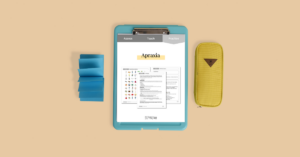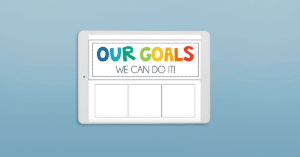This is a guest blog post from Rachel at SLP Now, a virtual, school-based speech-language pathologist, discussing how to write vocabulary goals for speech therapists!
Once we’ve evaluated and determined our student qualifies for speech therapy services and needs vocabulary intervention, it’s time to select our vocabulary targets for our goals.
Before writing your vocabulary speech goals, be sure to review how to write SMART goals to help your students and make your IEP as clear as possible!
Let’s dive into how to write vocabulary goals for your speech therapy students 😁
5 Areas to Target When Writing Vocabulary Goals for Speech Students
Speech-language pathologists target vocabulary goals across all ages. Depending on the age and needs of our students, the vocabulary goals we target can vary. Below are 5 targets for vocabulary goals to consider, however, they are not the only areas you can target! For more vocabulary goal ideas, head to SLP Now’s Goal Bank.
1. Core Vocabulary
For our emergent/early communicators, teaching core vocabulary is an important skill. In a study done by Fallon (2001), it was found that 89% of a preschooler’s vocabulary were made up of core words.
When writing goals for core vocabulary, choose targets based on high frequency and setting (Rytherford et al., 2020). You also want to make sure that you choose targets that express a variety of communication intents (Witkowski & Baker, 2012).
2. Basic Concepts
In the school-setting, understanding basic concepts is an important skill for our speech students to have.
Examples of Basic Concepts can include:
· Qualitative Concepts – big/little, hot/cold, and hard/soft
· Temporal Concepts – before/after, old/new, early/late
· Quantitative Concepts – full/empty, all/none, more/less
· Position Concepts – on/off, front/back, in/out, top/bottom
3. Describing/Association
As our students increase their vocabulary, we want them to be able to describe the words they are learning, as well as make associations between them.
The Expanding Expressions Tool is a good resource for this goal. This tool focuses on describing vocabulary based on group, function, appearance, composition, parts, and location.
4. Comparing and Contrasting
After students increase their ability to describe vocabulary, it is a good time to transition to goals that target comparing and contrasting. During this time, comparatives and superlatives (e.g. old/older/oldest, big/bigger/biggest) can come into play, and are a great way to target more complex syntax.
As stated in a previous post on selecting vocabulary targets, it’s all about the building blocks and building a solid foundation!
5. Multiple-Meaning Words
Evidence has shown that targeting multiple-meaning words is a good way to get the “bang for your buck” when it comes to teaching vocabulary.
Examples of Multiple-Meaning Words:
· Light
· Pupil
· Space
· Saw
· Trunk
Bonus: SLP Now’s Therapy Plan Vocabulary Activities include multiple-meaning word vocabulary activities!
SLP Now’s Vocabulary Goal Bank
Feeling stuck as a speech therapist when it comes to writing vocabulary goals?
SLP Now has a Vocabulary Goal Bank with a ton of vocabulary goal ideas for you to get inspiration from!
Vocabulary Goal Examples
· Student will identify comparatives (e.g. big/bigger, small/smaller), given an image, in 7/10 opportunities across three consecutive sessions.
· Student will identify spatial concepts (e.g. between, over, under), given an image, in 8/10 opportunities across three consecutive sessions.
· Student will describe an item using 4/7 descriptors (e.g., category, function, appearance, parts, location) across three consecutive sessions.
· Student will provide 2 definitions when given a multiple meaning word in 4/5 opportunities across three consecutive sessions.
How to Teach Vocabulary Goals to Speech Therapy Students
Now that we’ve discussed vocabulary goals for our speech therapy students, let’s take a brief look at the framework for teaching vocabulary.
1️⃣ Define New Words
2️⃣ Discuss New Words (Ask Questions)
3️⃣ Reread
4️⃣ Retell
5️⃣ Integrate New Words Into Activities
Click here for a more detailed explanation of the framework for teaching vocabulary!
SLP Now offers materials to assess, teach, and practice the vocabulary targets listed above & more!
References:
Rutherford, M., Baxter, J., Grayson, Z., Johnston, L., & O’Hare, A. (2020). Visual supports at home and in the community for individuals with autism spectrum disorders: A scoping review. Autism, 24(2), 447–469. https://doi.org/10.1177/1362361319871756
Witkowski, D., & Baker, B. (2012). Addressing the Content Vocabulary With Core: Theory and Practice for Nonliterate or Emerging Literate Students. Perspectives on Augmentative and Alternative Communication, 21(3), 74–81. https://doi.org/10.1044/aac21.3.74




Reader Interactions